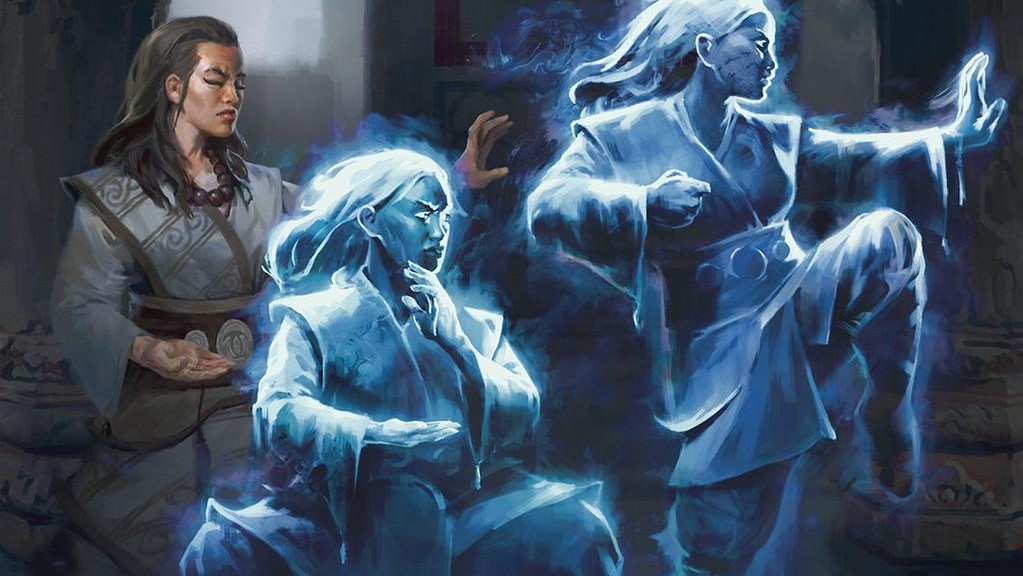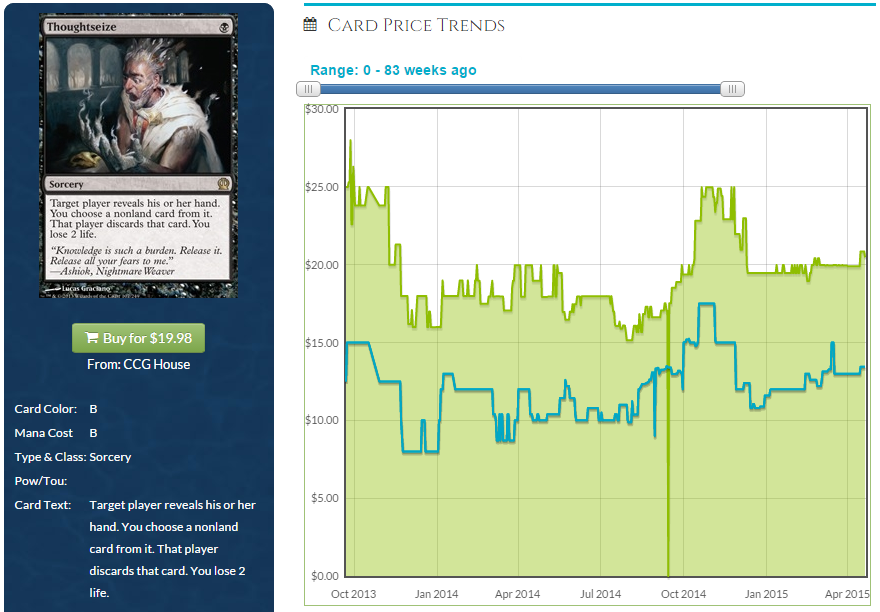By: Travis Allen
Ice has finally began to melt from Lake Erie, with only a few chunks of snow left visible on the now mostly liquid surface. There’s grass in my lawn again, I finally switched from my snow tires to my summer tires, and I’ve even worn flip flops outside once or twice. You can even smell it in the air. Have you noticed it yet? Take a big whiff—it’s the smell of an impending rotation.
Battle for Zendikar is five months away, but the financial implications for Theros block are already being felt. Temples are beginning to look a little like dead weights in thin plastic sleeves, most of us writers didn’t speak much or at all about Theros cards that showed up at the Pro Tour, and nobody is recommending picking up Fleecemane Lions for a flip off recent tournament success. Years and years ago, impending obsolescence didn’t hit until maybe mid-summer, but we’re past those days now. As it goes for people it goes for Magic cards; it’s never too early to start planning for retirement.
Now is a good time to discuss how best to handle set rotations and what they mean for your inventory management. When should you consider selling? What shouldn’t you sell? What if you can’t sell? Should you be buying?
You’re Already Too Late
Sadly, it’s true. The best time to begin divesting yourself of rotating staples is around November and December, and the real drop-off happens after March. If you ever read Chas Andres over on SCG—which you should—you’ll know that he frequently refers to the seasonal tides of Magic prices. The cycles are well known at this point. Overall price indexes peak sometime in the first three months of the year, and decline through August. As school begins and new block excitement builds, prices begin to climb again as the year wanes.
Of course, individual cards are not at all beholden to these cycles, and Standard cards especially see price changes based on more immediate circumstances. Consider the seasonal cycle a good rule of thumb. Buy during the summer when everyone is out enjoying the sun and sell when it’s too cold to be outdoors. It’s thematically adjusted sage advice from Warren Buffett, “Be greedy when others are fearful and fearful when others are greedy.”
Not only are we well past the peak of many Theros-block staples individually, we’re past the peak of the index as well.
It looks like Theros hit its stride right around November, shortly after Khans of Tarkir released. It has dipped since then, and the set will continue to lose value as we approach Battle for Zendikar’s release.
All is not lost, however. You still have time to move your Theros cards before they completely bottom out. Let’s check out Return to Ravnica, released one year prior to Theros.
Return to Ravnica, like Theros, peaked just after the fall release of the following subsequent block. It dwindled from there, and some time between March and April it really began to slide. The set was worth the absolute least a few months after it rotated, which was when Khans of Tarkir hit the format. For Theros, that time period will be this coming November and December.
At this time last year, the RTR index was about $220, and today, THS is about $200. By the time KTK hit last fall and RTR rotated, the set’s index had dropped to about $165. A loss of $55 represents a 25 percent drop from April to October. We are at that exact moment now, one year later. If history is to be repeated, that tells me that Theros still has a lot to drop between now and Battle for Zendikar; probably around $50 as a whole.
If for whatever reason you find yourself with a pile of Theros cards this July, you’re pot-committed at that point. Not only are those cards going to be worth almost nothing, there’s also the problem that nobody is going to want them. Rather than trade them away for pennies, just stash them someplace and revisit them down the road, when the Theros index begins to rise.
To sum up: we’re past the best time to sell out of Theros, but you still have time before we hit rock bottom.
Sell Everything, Except Not Everything
Generally you want to hang on to little from a set that’s on its way out the door, especially the banner Standard cards that haven’t made it into other formats. Stormbreath Dragon, and had it not been reprinted already, Elspeth, Sun’s Champion, would be perfect examples of this. Both cards are tier-one mega-staples in Standard, but just haven’t cut the mustard elsewhere. These are your “ship at all costs” cards. What you want to hang on to is the stuff that’s buoyed heavily by other formats, as those are the cards most likely to benefit in the longer term. From Return to Ravnica, an ideal example would be Abrupt Decay. While playable in Standard, it didn’t have run of the format like it does in Modern, and to a lesser extent, Legacy and Cube. It has fared well since rotation, and it’s a popular stock tip among many of the writers here at MTGPrice.
So what from Theros block do we want to hang on to?
Thoughtseize was the topic of hot discussion a few months ago. It seems like it peaked late last year, having since dropped a bit. I’m seeing growth in the buylist again at the tail end though, so I think this is a safe hold. My expectation is that Thoughtseize will suffer little if any loss in price as rotation occurs. A small bump in stock will occur as a few Standard players move their copies, though many will be shrewd enough to know that they should hang on to them. Supply will dry up through the winter and spring months, and by the time we hit fall of 2016 it will ideally have gained 10 to 30 percent from where we are now.
I’ve got most of my gods stashed away, as well. They’re driven purely by casual demand at this point, an indicator of resilience through rotation. If nobody is playing the card in Standard, then losing Standard legality will have virtually no impact on a price. Copies will slowly dry up in the coming months.
Foil Swan Songs are way underpriced in the $5 to $7 range. Eidolon of the Great Revel is a great mid-term hold, as it’s absolutely absurd in Modern and Legacy. This time next year, I’m hoping to sell all my copies in the $15 to $20 range, just ahead of the Modern PPTQ season.
Other than that… there’s not too much exciting out there this time around. Temples are a real clunker in old formats. Courser of Kruphix sees mild play in Modern, but not nearly enough to warrant holding on when most of its demand is Standard-based. There’s probably some EDH and casual fodder in there that will appreciate over time, I suppose. On the whole, I like trading away anything than the small list of cards above.
At a more general level, your goal is to hang onto cards that do not hold value because of Standard demand. You want casual all-stars and eternal staples. When considering if a card will see a drop in price or a rise after rotation, ask yourself where most of the copies are showing up: SCG Standard opens, Modern IQs, or kitchen tables? That will inform your decision.
If You Can’t Sell ‘Em, Trade ‘Em
I sell most of my cards on TCGplayer. It’s a convenient avenue for moving cards for those of us that do too much to want to regularly deal with eBay, and who don’t do enough to warrant our own web storefronts. (Also those of us that aren’t lucky enough to live in an area where there’s only one or two local stores and both of them will let you run their cases, but screw those guys.) While I’m happy with this tool, I completely understand that it’s not the right fit for many of you out there. Even just selling on eBay requires more of a web presence than many may be inclined towards, which is fine. That leaves local transactions, which often takes the form of trading. (Look into local Magic Facebook groups, though. There are a few for the city I live in, and can be an excellent way of organizing the sales of smaller quantities.)
Drilled into all of us is the desire to extract maximum value from our cards. Every time we open another binder, we want to take cards out of it whose sum total is worth more than what we give away. After all, that’s the root ideal of all of this, the writing, the ProTrader, the entire website and subculture. But what if I told you that sometimes, that isn’t the right choice? What if I told you that something bad…is actually good?
Basically, you shouldn’t be afraid to take a small loss on soon-to-rotate cards today if it means dodging a major loss on them tomorrow. I’ll give you a recent example. This past Friday, someone flipping through my binder expressed a passing interest in my Courser of Kruphixes and Sylvan Caryatids I hadn’t managed to get rid of just yet. My eyes lit up when he asked about them. He wasn’t exactly sure he wanted them, and was waffling a bit. Eager to make the trade, I gave him a few dollars in value on a $35 trade, and I made sure to let him know that I was doing that for him.
“I’ll make you a deal. I really need these Rhinos. I’ll give you those Coursers and Caryatid for these cards. You’re getting some value out of me, but I don’t mind.” Bam. I got rid of ticking time bombs, and I scored Siege Rhinos.
Had I been a stickler and demanded maximum trade value for those Coursers and Caryatids, that trade may not have happened. In fact, I’m almost sure it wouldn’t have. If that had been the case, I would have had those cards this coming Friday, when they may each be worth just a bit less than they were last week. And so on and so on, for multiple weeks, until each was worth half of what it had been when I had refused to give up a few bucks in trade. When you’re in the market to trade away cards ahead of rotation, don’t hesitate to sweeten the pot a bit for the person on the other side of the table. You’d much rather trade your $40 worth of Coursers for $35 today than trade the exact same playset for $20 in a month. (The same principle exists for trading away a card with a price tag that far outweighs its current play profile. Narset is exactly the type of card I would trade away for less than book value right now.)
Okay, but When Can I Spend My Money?
I’ve given you a lot of information about selling and trading your rotating cards away. How about buying them though? That’s easy. It’s almost always right around the November and December after rotation. Check out Snapcaster Mage, whose price floor was right around that first red line, which was late 2013—right after Innistrad had rotated from Standard.
A set’s price index is almost always at its lowest shortly after it rotates out of Standard. Everyone holding cards for Standard use, even the bad ones, is in the process of or have already traded them away. Markets are now saturated by these eternal staples and casual haymakers, and prices drop. As the respective markets begin soaking up the extra copies, typically by players who were patient and didn’t want to pay a Standard-legal tax, supply dwindles and prices rise as fewer and fewer liquid copies are available on the market. By the time you hit the spring set after rotation, e.g. Dragons of Tarkir when considering the 2014 rotation of Return to Ravnica, the index has already started to turn right side up. Here, take a look at that RTR graph again:
Notice the slight upturn around Fate Reforged and how it has continued up through Dragons of Tarkir. A slow growth sets in, and for the most part, prices rise continually from there.
Occasionally sets find their floor the summer after their release. Innistrad’s absolute floor was in August of 2012, just four months after Avacyn Restored had hit the street. It’s hard to predict if a set will bottom out during it’s first summer or if the true valley will be found sixteen months later in December, just after it rotates. Looking across all the indexes of the last few years, it seems that a big part of determining that is how strong the set is relative to other Standard sets, as well as how strong the cards are in other formats. That is to say that it’s damn difficult to predict only four or five months in whether a set is at its floor during the August immediately after its release or if you should wait until next winter. I’d say a good rule of thumb is to just wait until the December after the set releases. That would mean that this past December would have been the time to buy Return to Ravnica, and this coming December after Battle for Zendikar it will be time to buy any Theros cards you’re still missing.
Understand? Great, Now it’s All Irrelevant
Magic’s rotation schedule is about to undergo a sea change, and with it, the markets. Rarely in the last 15 or 20 years have we strayed from the formula of a new block in the fall which gets wrapped up in the spring. According to the wiki, the last two times we’ve seen much different was Lorwyn, which was still similar enough that it didn’t make a big difference, and Alliances, which is old enough to pre-date modern Magic finance.
How price cycles will be affected by such a titanic shift is anyone’s guess at this point. Cycles as we know them right now seem to be heavily influenced by two factors: the set’s temporal position to its lifespan in Standard, and the current calendar season. Under the new rotation, a set’s lifecycle will fall out of sync with seasons in a way that it never really has before. How will prices react with two new blocks each year instead of one? How will this interact with seasonal dynamics? Will this be enough to sustain demand through the summer? Will winter months buoy soon-to-rotate cards?
None of us know the answers to these questions, and the next two years are going to be a lesson for all of us. While I’ve spent this article speaking specifically about the current rotation model and how to approach it based on what month we’re in, the lessons will still be applicable to whatever the new rotation brings. You’ll still want to sell early, avoid getting stuck with rotating Standard staples, and pick up cards when they’ve recently rotated.
In the meantime, make sure you ditch Theros soon. Then go out and enjoy the warm weather. I’m going to go dust off my bike, pump up the tires, and bellyache about how uncomfortable my seat is.







Treat M15 just like Theros?
Of course.
I’m keeping my Chords and Sliver Hivelords for the long term though.